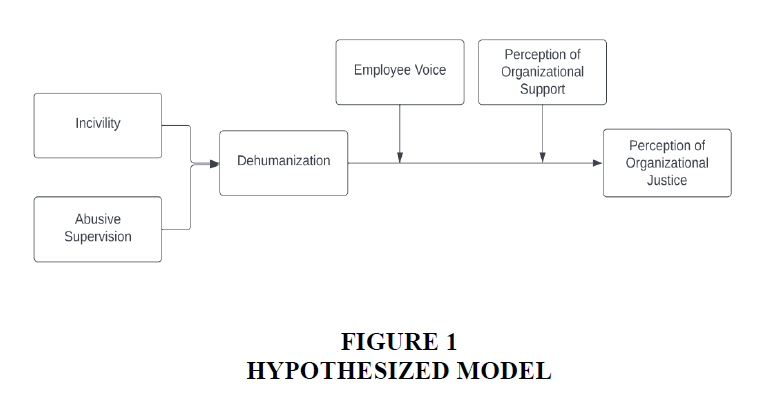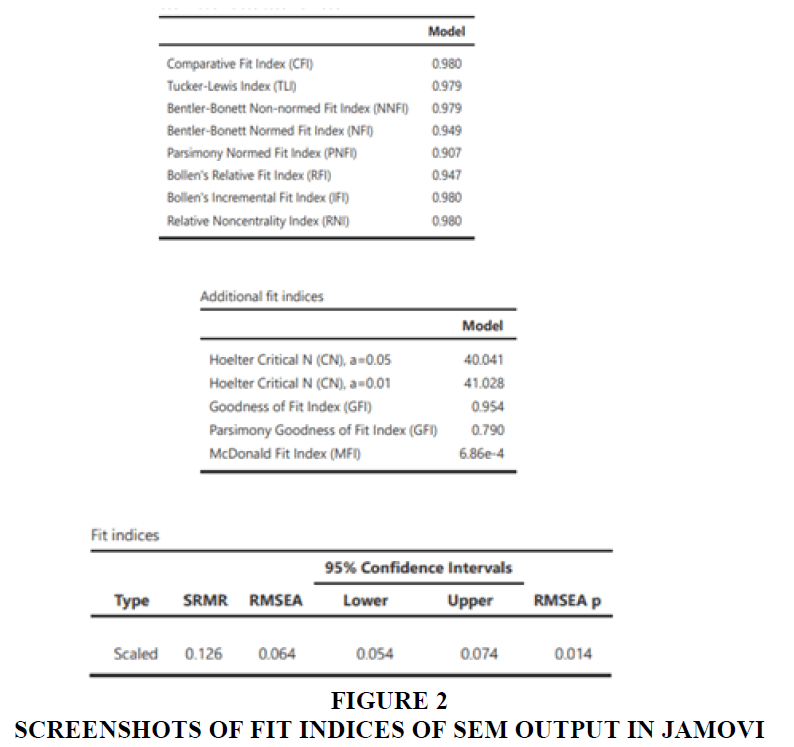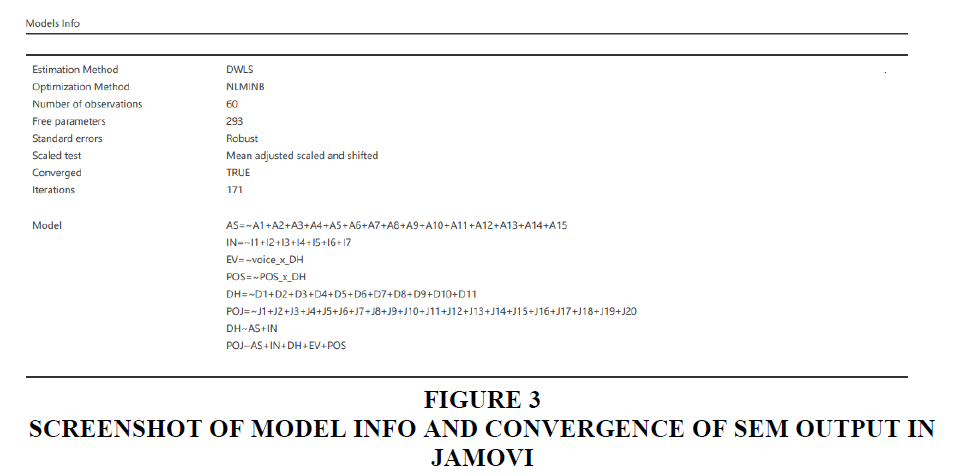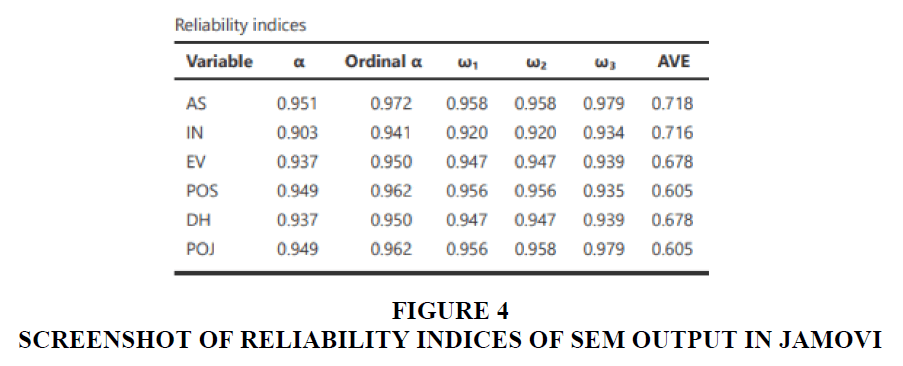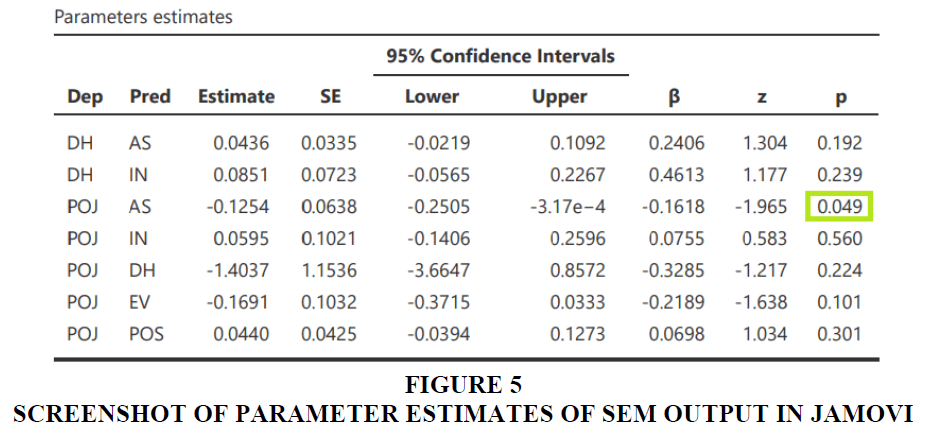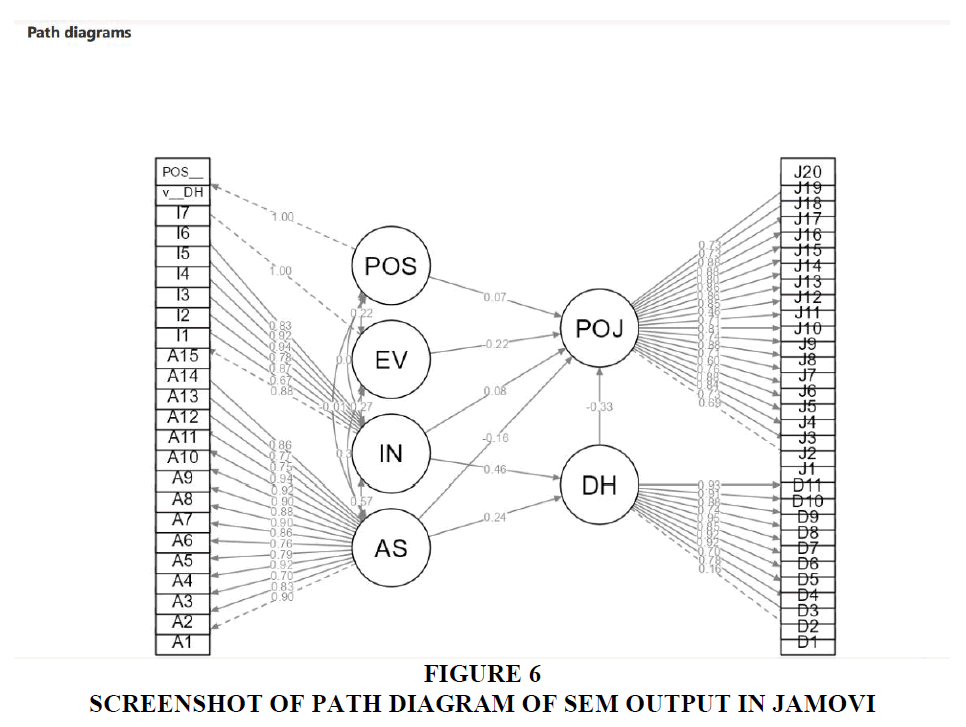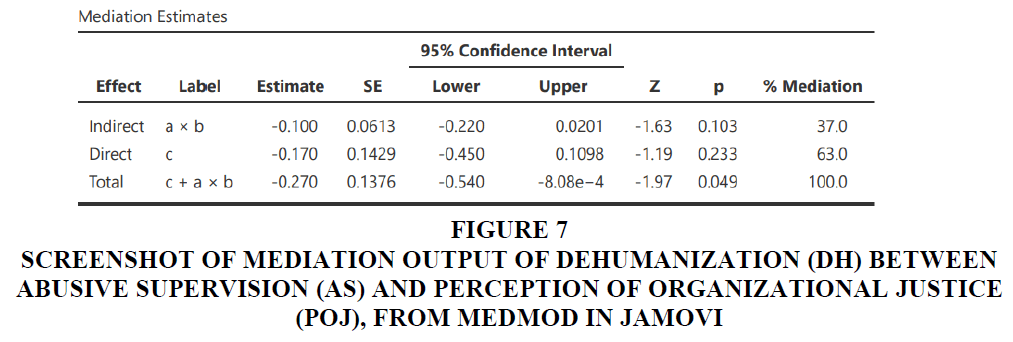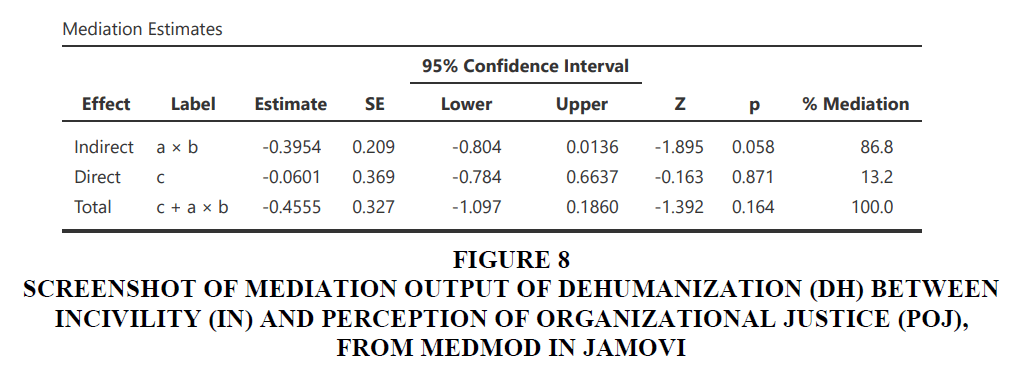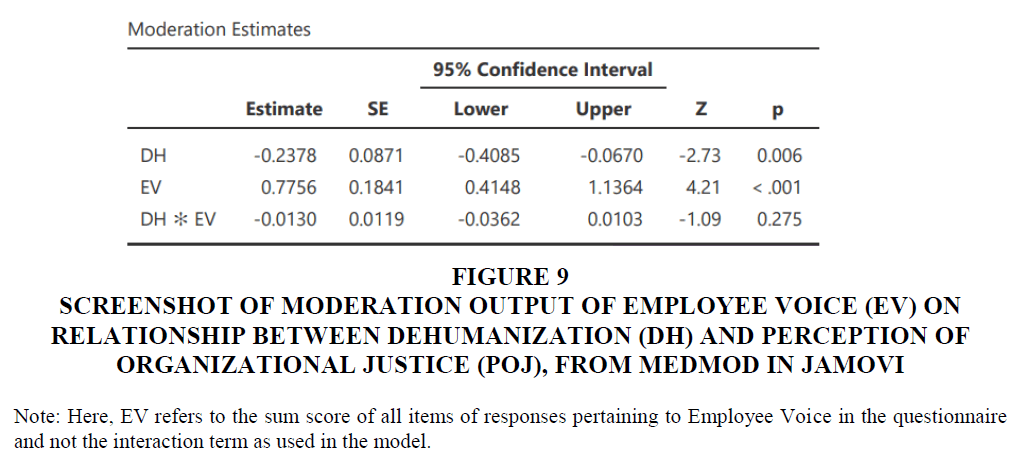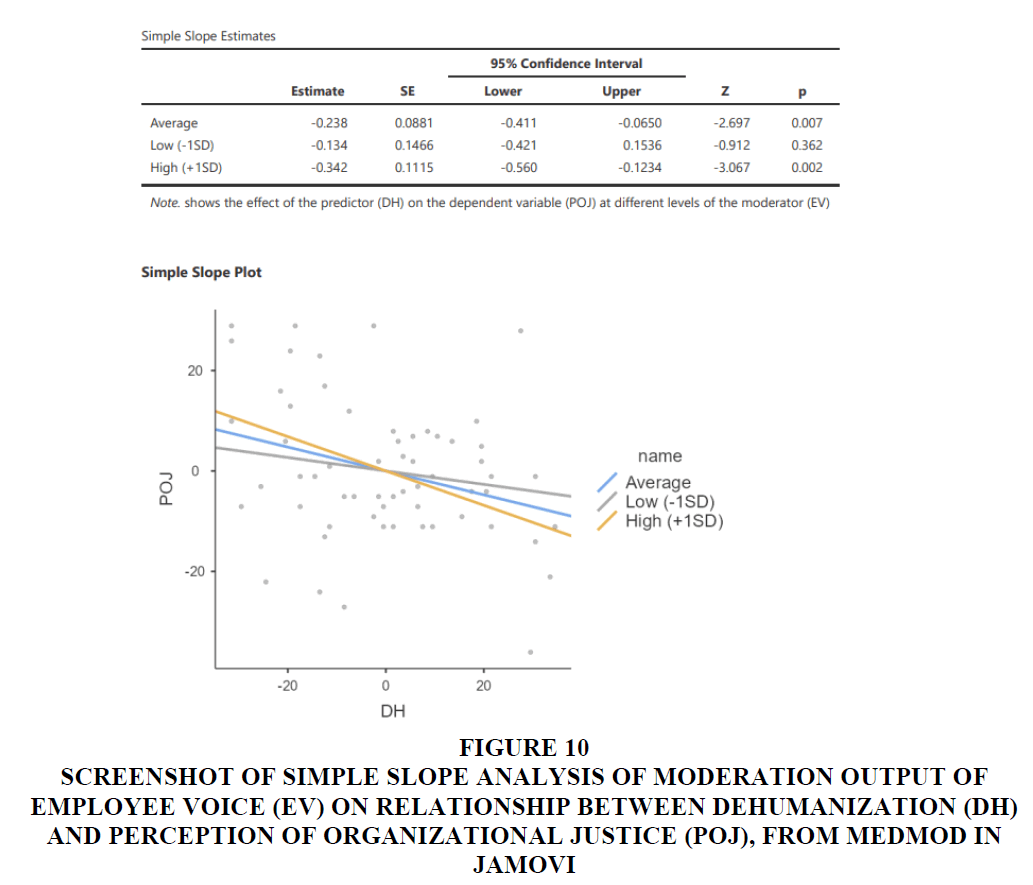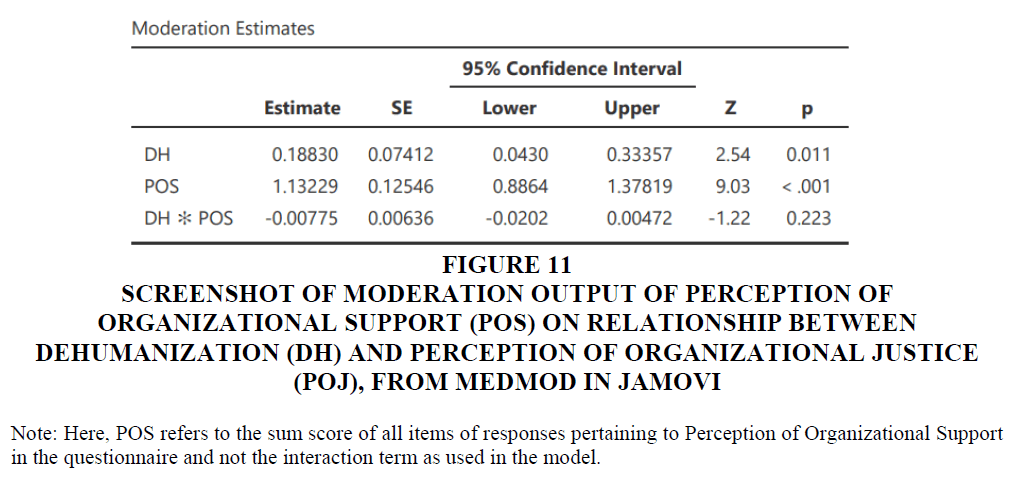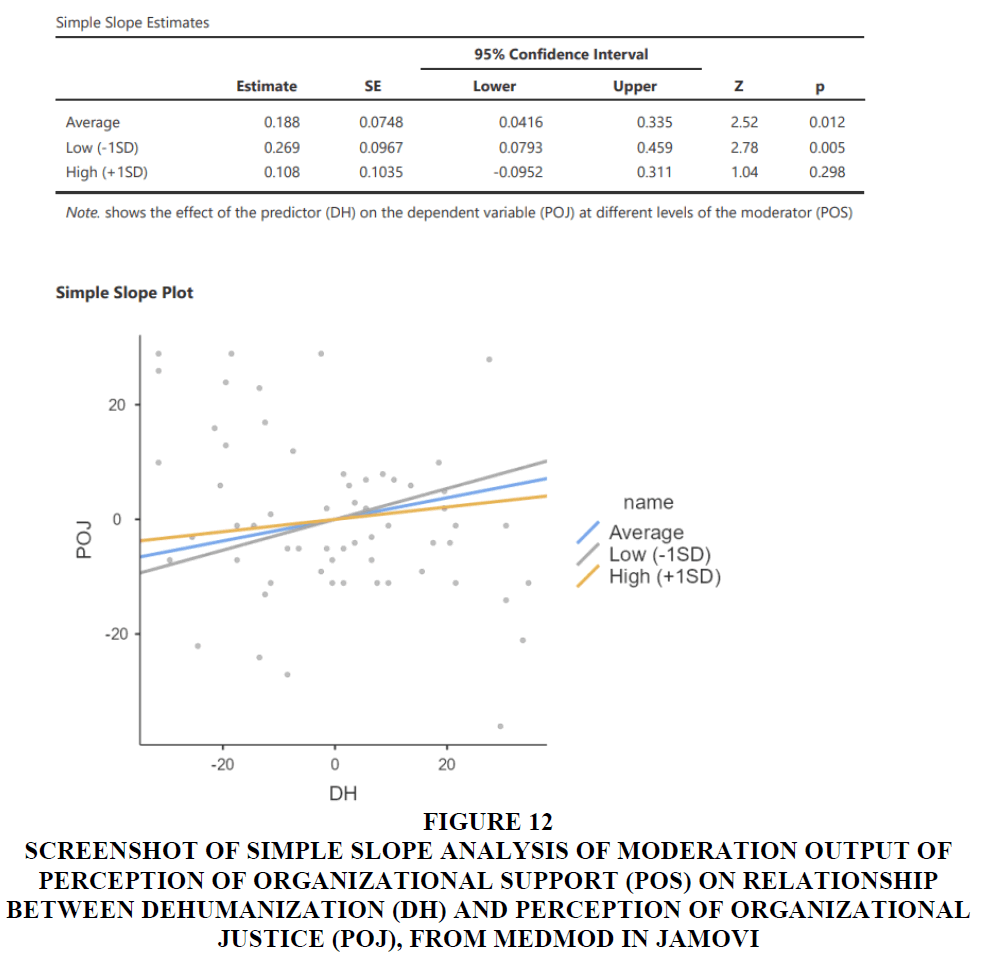Research Article: 2024 Vol: 28 Issue: 6S
Perception of Organizational Justice: The Role of Dehumanization, Abusive Supervision and Incivility
Monisha Meher, IT People Solutions, Micron Technology
Tumpa Dey, Institute of Management Technology Hyderabad, Hyderabad
Tulika Sharma, Institute of Management Technology Hyderabad, Hyderabad
Pavan Kr. Balivada, Institute of Management Technology Hyderabad, Hyderabad
Citation Information: Meher, M., Dey, T., Sharma, T., & Balivada, P.K. (2024). Perception of organizational justice: the role of dehumanization, abusive supervision and incivility. Academy of Marketing Studies Journal, 28(S6), 1-20.
Abstract
The ubiquity of workplace incivility, as well as the serious repercussions associated with it, has led many scholars to examine the different dynamics of this concern. The present study is based on JD-R (Job Demands-Resources) theory, by considering Incivility, Abusive Supervision, and Dehumanization as job demands and Perceptions of organizational Support and Justice, Employee Voice as job resources. A model had been developed to study the relationship between Abusive supervision, Incivility and Perception of Organizational Justice with Dehumanization being a mediator which also includes the extent to which Employee Voice, Perception of Organizational Support influence the relationship between Dehumanization and Perception of Organizational Justice. The study of this comprehensive mix had not yet been or in limited combination, was done by researchers. The study is done on employees of SMEs and IT/ITES companies; and SEM (Structural Equation Modelling), Moderation, Mediation modules were used in jamovi software to analyse the data to arrive at outputs and interpretations at confidence level of 95%. The results indicated that at significance level of 0.05; Abusive Supervision, Incivility, Dehumanization, Employee Voice, and Perception of Organizational Support are all linked to Perception of Organizational Justice. However, only the prediction of Abusive Supervision by Perception of Organizational Justice is significant. Further, the mediation analysis confirmed that there is no significant mediation of Dehumanization between Abusive Supervision and Perception of Organizational Justice, and between Incivility and Perception of Organizational Justice though 37% and 86.8% of the total effect is explained by indirect effect respectively. The moderation analysis confirmed that Employee Voice, Perception of Organizational Support are not significant mediators in relation between Dehumanization and Perception of Organizational Justice though at High value of moderator: Employee Voice the effect is significant and at Low level of moderator: Perception of Organizational Support the effect is significant. Organizations can use this model to vary the perceptions by controlling the mentioned constructs and also, they can take few preventive measures by using the interpretation of study that at high level of Dehumanization and high level of Employee Voice, the Perception of Organizational Justice increases; and that at high level of Dehumanization and low level of Perception of Organizational Support, the Perception of Organizational Justice decreases. However, the insignificance of effects of few constructs in the model may be due to influence of sample size, model complexity, and other factors on parameter estimates. Hence organizations are advised to note that few effects which are been shown as insignificant in output may be having significant effects in real scenarios.
Introduction
Incivility, abusive supervision, and dehumanisation are all examples of negative workplace behaviours that can result in negative emotions. Employees who witness these behaviours may feel less comfortable expressing their opinions and ideas, reducing their sense of employee voice. Employees are more likely to express their opinions and ideas when they feel supported and believe that their organisation values their contributions and cares about their well-being. Organizational justice perception is also important because it reflects an employee's belief that the organization's policies and procedures are fair and just. Employees who believe they are treated fairly are more likely to be satisfied with their jobs and committed to the organisation. Perceptions of organisational support and justice can also act as buffers against negative behaviours such as incivility, abusive supervision, and dehumanisation. Employees may be better able to cope with negative behaviours and reduce their negative impact if they feel supported and believe their organisation is fair.
Incivility is defined as low-intensity negative behaviour that violates workplace respect norms and can include making rude comments, ignoring or excluding someone, or undermining someone's work. It can result in negative emotions and decreased job satisfaction.
Abusive supervision goes beyond incivility and involves a supervisor using power to intimidate, belittle, or humiliate an employee. This can lead to stress, anxiety, and poor job performance.
Dehumanization is defined as treating someone as less than human, such as using derogatory language or denying their basic needs. This can result in feelings of worthlessness and low motivation.
Employee voice refers to how comfortable employees feel expressing their opinions and ideas at work. Employees are more likely to be engaged and satisfied with their jobs when they feel heard and valued.
An employee's perception of organisational support refers to their belief that their organisation values their contributions and is concerned about their well-being. This can result in increased job satisfaction and dedication.
The belief of an employee that the organization's policies and procedures are fair and just is referred to as perception of organisational justice. Employees who believe they are treated fairly are more likely to be satisfied with their jobs and committed to the organisation.
According to the JD-R (Job Demands-Resources) theory, work characteristics can be classified into two types: “job demands and job resources” (Schaufeli & Bakker (2004). Job demands are the aspects of physical, social, or organisation of a job that require consistent effort or are closely linked with costs that are physiological or psychological. Job resources, on the other hand, are the physical, psychological, social, or organisational aspects of a job that help achieve work goals, reduce job demands, and promote growth and development. Overall, the JD-R model can assist us in understanding how work characteristics can influence employee well-being and motivation, as well as how positive job resources can mitigate the negative effects of job demands. This theory emphasises the significance of creating a place of employment that fosters positive job resources while minimising the negative effects of job demands.
Pertaining to present study, according to the JD-R model, incivility, abusive supervision, and dehumanization can be considered as job demands that can place a strain on employees and require them to use up their resources to cope with these negative experiences. Perceptions of organizational support and justice, on the other hand, can be considered as job resources, and when combined with employee voice, they can help alleviate the negative effects of job demands and can provide employees with the resources they need to deal with difficult situations. Hence, a model has been constructed around with Abusive Supervision, Incivility, Dehumanization, Employee Voice, Perception of Organizational Support and Perception of Organizational Justice. Dehumanization is used as mediator to explain the effect of Abusive Supervision, Incivility on Perception of Organizational Justice. Employee Voice, Perception of Organizational Support are used as moderators to explain the effect of Dehumanization on Perception of Organizational Justice.
Literature Review
Abusive Supervision is when employees perceive that their supervisors consistently exhibit hostile verbal and non-verbal behavior, without involving physical contact (Tepper, 2000). The term abusive supervision is used to describe subordinates' evaluations of the level of hostile verbal and non-verbal behavior displayed by their leaders, while excluding physical contact, over a prolonged period of time. One of the areas of our research that has been intriguing, and has also been examined by numerous other researchers Srivastava, et al. (2022); Tepper (2000), is the impact of abusive supervision on workplace incivility. Research carried out in India (Srivastava et al. 2022) found that abusive supervision has a positive effect on both employee misconduct and their intention to leave their job. Andersson & Pearson, (1999)
When employees engage in deviant workplace behavior, such as counterproductive and negligent work behavior, it is often categorized as incivility (Pearson et. al, 2005; Andersson, & Pearson, 1999). Workplace bullying and other forms of deviant behavior are considered more serious than incivility. Workplace incivility is differentiated from other kinds of unproductive behavior and interpersonal aggression, which involves intentionally harming others (Cortina et al., 2001). The consequences of workplace incivility are numerous and can include mental stress, decreased job satisfaction (Eisenberger et al, 1999), heightened anxiety (Halbesleben & Buckley, 2004), diminished organizational citizenship behavior, violent conduct (Andersson & Pearson 1999) decreased organizational commitment (Suliman & Kathairi, 2013). and a strong intention to leave one's job which is nothing but turnover (Griffeth, Hom & Gaertner, 2000; Kang & Sung (2019). An integrative framework was proposed and used to examine the factors that contribute to workplace incivility in a different study (Han et al, 2022; Lim & Cortina, 2005).
The term organizational dehumanization refers to how an employee feels objectified by their organization and stripped of their personal subjectivity, leaving them feeling like a mere tool or instrument for the organization's benefit (Stinglhamber, & DaWilde, 2017). In Bell and Khoury's (2016) study, it was discovered that the perception of organizational dehumanization in female employees increased their intention to leave their job, while procedural justice had the opposite effect. Baldissarri, et al. (2014) found that when employees felt they were being treated like a tool by their supervisors, they reported greater levels of job burnout, including emotional exhaustion and cynicism. This, in turn, led to a sense of internalized objectification, wherein the employees perceived themselves as lacking in human mental capacity. In their study, Sarwar et al. (2021) found that both organizational dehumanization and perceived incivility had a negative impact on employee performance. Perception of Organizational Support, which is a measure of an organization's positive view of its employees and its commitment to their well-being and contributions, was also found to play a significant role (Eisenberger et al, 1986).
Employee voice, as defined in the Organisational Behaviour literature, is an employee's voluntary and expressive engagement in work-related matters (Pohler & Luchak, 2014; Dundon, et al. 2014). There have been significant developments in the study of employee voice in the workplace, which have shed light on how organizations can create environments that promote greater expression and participation among employees, both as individuals and as a collective. For instance, Dundon, et al. (2004) have proposed a range of organizational initiatives aimed at facilitating individual and collective expression in decision-making and addressing dissatisfaction.
Eisenberger et al. suggested that employees develop a perception of how much the organization values their contributions and cares about their well-being, which is called perceived organizational support (POS). When employees perceive high POS, their need for approval, esteem, and social identity is met, and they expect recognition and reward for superior performance and extrarole behavior. This strong organizational support leads to positive job attitudes, including job satisfaction, and employees are more likely to reciprocate by caring about the organization and performing well. In contrast, employees who do not feel supported by the organization may withhold effort, resulting in lower performance levels and negative job attitudes. Rhoades and Eisenberger (2002) meta-analysis demonstrated a significant positive correlation between perceived organizational support and job satisfaction and a positive relationship between perceived organizational support and job performance (Folger, 1977; Pohler & Luchak, 2014).
According to scholars, organizational justice is best understood as the perception of organizational justice (POJ), which refers to how employees view an organization's fairness and ethical treatment of employees (Suliman & Kathairi, 2013; Thibaut & Walker; 1975). There are generally four types of POJ that scholars agree upon: procedural justice, interactional justice, distributive justice, and informational justice. Procedural justice is an employee's perception of fairness in the procedures or methods used to determine outcome allocation Thibaut & Walker, 1975). For procedures and methods to be considered fair, employees must perceive them as consistent, accurate, correctable, and unbiased (Lind & Tyler, 1988). Voice is a critical component of procedural justice, as giving employees a voice in allocation proceedings makes them believe that the procedures are fair, even when the outcome is unfavorable to them (Pohler & Luchak, 2014). Interactional justice, on the other hand, refers to the perceived fairness of the interpersonal treatment that employees receive from management and authority figures. Distributive justice primarily concerns equity perception of reward/pay distribution in relation to workloads and has been studied extensively as a key factor that impacts workplace attitudes and behaviors. Interpersonal justice relates to civility and decency, whereas informational justice refers to the sincerity and honesty with which acts and features of processes are explained. Kang & Sung (2019) conducted a study on the impact of perceptions of organizational justice on employee turnover intention via employee-organization relationship and employee job engagement.
There have been numerous studies on the Job Demands-Resources theory, and several of them are noteworthy. For instance, Bakker and Demerouti, (2007) offered a comprehensive explanation of the JD-R model, including its theoretical basis, essential concepts, and empirical support. In an earlier version of the JD-R model, Demerouti, Bakker, Nachreiner & Schaufeli (2001) emphasized the importance of job demands and resources in the development of burnout. applied the JD-R model to the teaching context and found that job resources such as autonomy and social support can offset the negative effects of job demands on burnout and promote engagement (Schaufeli & Bakker, 2004). In a critical review of burnout research, Halbesleben & Buckley (2004) emphasized the importance of identifying underlying job demands and resources that contribute to burnout. Schaufeli and Bakker (2004) conducted a multi-sample study that supported the JD-R model, finding a positive relationship between job demands and burnout and a positive relationship between job resources and work engagement. The authors concluded that the JD-R model is a useful framework for understanding the complex interactions of job demands and workplace resources.
Research Gap
The literatures on Abusive supervision, Incivility or in workplace, Dehumanization, Employee Voice, Perception of Organizational Support, Perception of Organizational Justice evolved separately or with very limited relationship evaluations, and no empirical research has examined the extent to which these behaviors are related; no research model had been ever proposed with these variables comprehensively. Also, with respect to JD-R model, much of the work was done with respect to job burnout and therefore mentioned variables have not yet been explored. Hence, this can be seen as a research gap and the present work addresses it by hypothesising a model that studies the relationship between Abusive supervision, Incivility and Perception of Organizational Justice with Dehumanization being mediator and Employee Voice, Perception of Organizational Support being moderators between Dehumanization and Perception of Organizational Justice.
Research Methodology
For this, study both secondary and primary research have been performed.
Secondary research: More than 30 research papers and articles have been studied from portals like Google Scholar, ProQuest and resources provided by the institute.
Primary research: A survey was conducted to gather data of employees pertaining to our constructs of study: Abusive Supervision, Incivility in workplace, Dehumanization, Employee Voice, Perception of Organizational Support, Perception of Organizational Justice. A questionnaire was distributed to 100 employees, many of the participants, 76.3%, were in the age group of 25-45 years, while 23.7% were in the age group of below 25 years. Most of the participants are currently working in IT/ITES sector (62.7%), 11.9% in Manufacturing sector, 6.8% in services sector, 1.7% in BPO and the remaining in some other sectors. The survey did not assess the participants' knowledge of Abusive Supervision, Incivility in workplace, Dehumanization, Employee Voice, Perception of Organizational Support, Perception of Organizational Justice, but only collected their experiences and perceptions of the same.
Instrumentation: Each of the constructs (Abusive Supervision, Incivility in workplace, Dehumanization, Employee Voice, Perception of Organizational Support, Perception of Organizational Justice) are measured by using already established instruments from various established and highly cited research papers. Each item and the instrument are as below:
Abusive Supervision: The instrument for Abusive Supervision was adopted from the paper- Consequences of Abusive Supervision by Tepper (2000).The items were rated on a five-point Likert response scale. Sample items include: “My boss ridicules me”, “My boss expresses anger at me when he/she is mad for another reason”. The final scale was created by taking sum of response to the 15 items.
Incivility: The instrument for Incivility was adopted from the paper- Incivility in the Workplace: Incidence and Impact by Cortina et al (2001). The items were rated on a five-point Likert response scale. Sample items include: During the past 5 years while employed have you been in a situation where any of your supervisors or co-workers “Put you down or was condescending to you?”, “Made demeaning or derogatory remarks about you”. The final scale was created by taking sum of response to the 7 items.
Dehumanization: The instrument for Dehumanization was adopted from the paper- Perceived Organizational Support and Employees’ well-being: the mediating role of Organizational Dehumanization by Stinglhamber and DaWilde(2017).The items were rated on a seven-point Likert response scale. Sample items include: “My organization considers me as a tool to use for its own ends”, “The only thing that counts for my organization is what I can contribute to it”. The final scale was created by taking sum of response to the 11 items.
Employee Voice: The instrument for Employee Voice was adopted from the paper- Helping and Extra-role Behaviors: Evidence of Construct and Predictive Validity by Van Dyne and Jefferey (1998). The items were rated on a seven-point Likert response scale. Sample items include: “My organization considers me as a tool to use for its own ends”, “The only thing that counts for my organization is what I can contribute to it”. The final scale was created by taking sum of response to the 6 items.
Perception of Organizational Support: The instrument for Perception Of Organizational Support was adopted from the paper- Perceived Organizational Support, Discretionary Treatment, and Job Satisfaction by Eisenberger et al (1997). The items were rated on a seven-point Likert response scale. Sample items include: “My organization strongly considers my goals and values”, “My organization would forgive an honest mistake on my part”. The final scale was created by taking sum of response to the 8 items.
Perception of Organizational Justice: The instrument for Perception Of Organizational Justice was adopted from the paper- On the dimensionality of organizational justice: A construct validation of a measure by Colquitt (2001). The items were rated on a five-point Likert response scale. Questionnaire includes questions pertaining to procedural justice, Distributive Justice, Interpersonal Justice, and Informational Justice. Sample questions are: “The following items refer to the procedures used to arrive at your (outcome). To what extent: Have those procedures been free of bias? “, “The following items refer to your (outcome). To what extent: Is your (outcome) justified, given your performance?”, “The following items refer to (the authority figure who enacted the procedure). To what extent: Has (he/she) treated you with dignity?”, “The following items refer to (the authority figure who enacted the procedure). To what extent: Were (his/her) explanations regarding the procedures reasonable?”. The final scale was created by taking sum of response to the 20 items.
Model: Based on gap already explained in the section of Literature Review and JD-R theory, the following model has been constructed around with Abusive Supervision, Incivility, Dehumanization, Employee Voice, Perception of Organizational Support and Perception of Organizational Justice. Dehumanization is used as mediator to explain the effect of Abusive Supervision, Incivility on Perception of Organizational Justice. Employee Voice, Perception of Organizational Support are used as moderators to explain the effect of Dehumanization on Perception of Organizational Justice Figure 1-9.
Figure 7 Screenshot of Mediation Output of Dehumanization (DH) Between Abusive Supervision (AS) and Perception of Organizational Justice (POJ), from Medmod in Jamovi
Figure 8 Screenshot of Mediation Output of Dehumanization (DH) between Incivility (IN) and Perception of Organizational Justice (POJ), from Medmod in Jamovi
Figure 9 Screenshot of Moderation Output of Employee Voice (EV) on Relationship between Dehumanization (DH) and Perception of Organizational Justice (POJ), from Medmod in Jamovi
Method of Analysis: This study employs SEM (Structural Equation Modelling) using jamovi software to test the model. The dependent variable in simultaneous regression is limited to one independent variable, whereas the number of endogenous and exogenous variables in SEM is not limited. Because of this fundamental distinction, SEM modelling employs a much more sophisticated and advanced type of regression. Structural equation modelling (SEM) is a statistical technique for analysing relationships between multiple variables. It is a multivariate statistical analysis technique that combines factor analysis and regression analysis to model complex variable relationships. The structural equation model specifies a set of relationships between latent variables that cannot be directly observed and observed variables that can be directly measured. It is used to test the hypothesis that a group of variables have a causal relationship with one another. It can be used to investigate the direct and indirect relationships between variables, as well as to assess the fit of a theoretical model to observed data. Moderating and Mediating effects are also analysed using jamovi software through medmod module.
Results and Interpreation
Model Testing: To assess the model developed, Structural Equations Model (SEM) was employed in jamovi software. The constructs in the model are denoted as -
AS: Abusive Supervision
IN: Incivility
DH: Dehumanization
EV: Employee Voice
POS: Perception of Organizational Support
POJ: Perception of Organizational Justice
A1 to A15 are items related to AS: Abusive Supervision, I1 to I7 are items related to IN: Incivility, D1 to D11 are items related to DH: Dehumanization, J1 to J20 are items related to POJ: Perception of Organizational Justice.
For Employee Voice and Perception of Organizational Support, we use them as exogeneous variables by calculating their interactions in SPSS software with the independent variable (here: Dehumanization) following Baron and Kenny (1986) method. Baron and Kenny’s method can be used to test moderation effects by incorporating interaction variables between the independent variable and the moderator variable in the analysis as exogenous variables Suliman, & Kathairi, (2013).
Fit Indices: Fit indices are used in Structural Equation Modeling (SEM) to assess how well a hypothesised model fits the observed data.
The Comparative Fit Index (CFI) compares the proposed model to a null model (i.e., a model with no relationships among the variables). A CFI value of 0.90 or higher is considered an acceptable fit, while 0.95 or higher is considered a good fit. Tucker-Lewis Index (TLI) - Like the CFI but penalises for model complexity more. A TLI of 0.90 or higher is generally considered an acceptable fit, while 0.95 or higher is considered a good fit. From the output screenshot of SEM, both the fit indices are above 0.95 hence the model is considered to have a good fit. The Goodness of Fit Index (GFI) is also above 0.95, hence it can be concluded that model fits the data adequately.
RMSEA (Root Mean Square Error of Approximation) is a statistical measure used in SEM (Structural Equation Modeling) to evaluate a model's goodness-of-fit. RMSEA measures how well the model fits the data by comparing the differences between the observed and predicted data. RMSEA considers the number of degrees of freedom in the model and ranges from 0 to 1. A lower RMSEA value indicates that the model and data are better fit. RMSEA values of 0.05 or less are considered good, while values between 0.05 and 0.08 are considered acceptable. Values greater than 0.10 indicate a poor fit between the model and the data. The output shows RMSEA of 0.06 which means it is acceptable.
Convergence: The output reported that model had converged. During the estimation procedure, convergence in SEM refers to the process of arriving at a stable solution for the model's estimated parameters (e.g., path coefficients, factor loadings). SEM estimation is an iterative process of refining the estimated parameters until the difference between the estimated model and the observed data is minimised. This process typically entails estimating the model parameters, evaluating the model fit, and then re-estimating the parameters based on the model fit evaluation. Convergence occurs when the iterative estimation procedure reaches a point where the estimated parameters no longer vary significantly between iterations and the model has found a stable solution. This means that the model fits the data well and that the estimated parameters have converged to their best possible values. If convergence is not achieved, it may indicate that the model is not a good fit to the data or that the estimation procedure is not working properly. In this case, it may be necessary to modify the model, adjust the estimation procedure, or examine the data to identify potential sources of error.
Hence the output here of Converged: TRUE indicates a good fit and that there is no need of modification. The convergence output and model syntax can be seen from below screenshot of SEM output.
Reliability: The degree to which a measure or scale consistently and accurately assesses the construct it is intended to measure is referred to as reliability in the context of Structural Equation Modelling (SEM). In other words, it is the degree to which the measure yields consistent results over time, across different samples or populations, and under various conditions. The accuracy and consistency of the measures used in the model are critical for ensuring the validity of the results, so reliability is an important aspect of SEM. Higher reliability coefficients, in general, indicate that a measure is more accurate and consistent in assessing the construct of interest, which can increase the validity of the SEM results.
Cronbach's alpha (α), a measure of internal consistency, is shown in the first column. The values range from 0 to 1, with larger values indicating greater reliability. When its value is between 0.7 to 0.9 is said to have good internal consistency and when above 0.9 is said to have excellent internal consistency. As evident from output screenshot, all values of Cronbach's alpha (α) here are greater than 0.9, hence there is excellent internal consistency.
The second column is Ordinal alpha. Ordinal alpha is a reliability coefficient used in Structural Equation Modelling (SEM) to assess the internal consistency reliability of ordinal-item measures. It is a Cronbach's alpha coefficient variant that takes the ordinal nature of the items in the measure into account. When the measures have ordinal items, such as Likert scales, it is a commonly used reliability coefficient in SEM. Cronbach's alpha assumes that the items in the measure are interval or continuous and thus equal in terms of their distance from each other. However, in ordinal-item measures, the distance between response options may not be equal, and treating them as such may result in a biased estimate of reliability. Ordinal alpha overcomes this limitation by incorporating the ordinal nature of the items into the estimation of reliability. Ordinal alpha generally has values between 0 to 1, with high values depicting more internal consistency and measure reliability. As evident from output screenshot, all values of Ordinal alpha here are greater than 0.9, hence there is excellent internal consistency.
Omega is a family of reliability coefficients used in Structural Equation Modelling (SEM) to assess internal consistency and reliability. The third column displays omega (ω1), an alternative measure of internal consistency that takes the data's factor structure into account. The fourth column displays omega hierarchical (ω2), which is a reliability estimate that takes both the factor structure and the hierarchical structure of the data into account. The fifth column displays omega total (ω3), a reliability estimate that considers both the factor structure and the amount of common variance in the data. Omega coefficients can range from zero to 1, with higher values indicating more internal consistency reliability of the measure. In SEM, omega coefficients are preferable to Cronbach's alpha coefficients because they account for the complex factor structure of the measures and provide more accurate estimates of reliability. For this model, the output of omega for all is more than 0.9, hence all of them have greater internal consistency reliability.
The last column displays the extracted average variance (AVE), which is a measure of convergent validity. To indicate that the latent variable explains more than half of the variance in its indicators, AVE values should be greater than 0.5. For this model, the output of AVE for all is more than 0.6, hence all of them meet the criterion.
Parameter Estimates: Parameter estimates in Structural Equation Modelling (SEM) are the values assigned to the model's parameters based on the sample data. Model estimation, which involves using a sample of data to calculate the maximum likelihood estimates of the model's parameters, is used to obtain parameter estimates. SEM gives parameter estimates that provide information about the strength, direction, and statistical significance of the model's hypothesised relationships between variables. They can be used to test hypotheses about variable relationships and to assess the model's overall fit to the data.
In SEM, the significance of an estimate indicates whether the relationship between two variables is statistically meaningful or whether it is likely to be due to chance. SEM assesses the significance of an estimate by examining its associated p-value, which represents the probability of observing the estimated relationship in a sample of data if there is no true relationship in the population. The conventional threshold for statistical significance in SEM is a p-value of 0.05 or less (for the present study 95% confidence level is considered). Therefore, if an estimate has a p-value less than 0.05, it is generally considered statistically significant. From the above output screenshot only the prediction of POJ by AS is significant.
Path Model: A path diagram represents a structural equation model graphically. It depicts the relationships between the latent and observed variables as boxes with arrows connecting them. The paths, or hypothesised relationships between the variables, are represented by the arrows, which can be interpreted as causal links or correlations. It denotes a cause-and-effect relationship between latent and observed variables. In a path diagram, the numbers between the arrows represent the estimated regression coefficients or path coefficients, which are denoted by beta (β) in statistical analysis.
The standardised regression coefficient, represented by the beta value, indicates the strength and direction of the relationship between two variables. The beta value represents the change in the dependent variable (in standard deviation units) associated with a one standard deviation increase in the independent variable, while all other variables in the model remain constant. A beta value can be positive, negative, or zero, indicating for the two variables under consideration whether there is a positive, negative, or null relationship. The beta value has a magnitude that is ranging from 0 to 1, with higher values indicating a stronger relationship between the variables.
The following model proves that there exists a relationship between Abusive Supervision, Incivility, Dehumanization, Employee Voice, Perception of Organizational Support with Perception of Organizational Justice. But, the estimates output makes it clear that only the prediction of POJ by AS is significant.
Though the remaining effects are insignificant, it is worth noting that statistical significance does not necessarily imply practical significance or substantive importance. Furthermore, sample size, model complexity, and other factors can all influence the significance of parameter estimates. Hence once little modifications are done with respect to data and variables, the effects might turn significant.
Mediation and Moderation: Mediators and moderators are variables in SEM that can affect the relationship between independent and dependent variables in a model.
A mediator variable is a variable that exists between the independent and dependent variables and aids in explaining how and why they are related. In other words, the mediator variable bears some or all the independent variable's effect on the dependent variable. A SEM can represent mediator variables by specifying a path from the independent variable to the mediator variable and a path from the mediator variable to the dependent variable.
The strength or direction of the relationship between independent and dependent variables is influenced by a moderator variable. It can change the relationship between variables by amplifying or attenuating the independent variable's effect on the dependent variable. Moderator variables are typically represented in SEM by interaction terms, which are calculated by multiplying the independent variable by the moderator variable.
Mediation and Moderation analysis are conducted in medmod module of jamovi.
When a relationship between an independent variable and a dependent variable is mediated by a third variable, direct, indirect, and total effects are used to assess the relationship (mediator). Total effect gives the impact of independent variable on dependent variable without the involvement of mediator. Indirect effect gives the impact of independent variable on dependent variable through the mediating variable. In the presence of a mediator, the direct effect describes the impact of the independent variable on the dependent variable. In simple terms, if the indirect effect is insignificant, it means that there is no mediation.
Here, in the output the indirect effect is insignificant (p>0.05) hence there is no mediation of Dehumanization (DH) between Abusive Supervision (AS) and Perception of Organizational Justice (POJ) through 37% of the total effect is explained by indirect effect; however, the total effect is significant which implies that effect of Abusive Supervision (AS) on Perception of Organizational Justice (POJ) is significant. We can also verify with estimates output as in Figure 05.
Here, in the output the indirect effect is insignificant (p>0.05) hence there is no mediation of Dehumanization (DH) between Incivility (IN) and Perception of Organizational Justice (POJ) through 86.8% of the total effect is explained by indirect effect; the total effect is also insignificant which implies that effect of Incivility (IN) on Perception of Organizational Justice (POJ) is insignificant. We can also verify with estimates output as in Figure 5.
Here, in the output the co-efficient of Dehumanization (DH) on Perception of Organizational Justice (POJ) is significant (p<0.05), the co-efficient of Employee Voice (EV) on Perception of Organizational Justice (POJ) is significant (p<0.05) & the interaction effect of Employee Voice (EV) and Dehumanization (DH) on Perception of Organizational Justice (POJ) is non-significant (p>0.05). Hence, Employee Voice (EV) is not mediator in relation between Dehumanization (DH) and Perception of Organizational Justice (POJ) and can be a probable predictor of Perception of Organizational Justice (POJ).
Simple slope analysis in SEM (Structural Equation Modeling) is a statistical method used to investigate the nature and strength of a relationship between two variables by estimating the slope of the relationship at different values of a third variable known as the moderator. At different levels of the moderator variable, the simple slope analysis provides information on the strength and direction of the relationship between the two variables. This information can assist in determining the conditions under which the relationship is strongest or weakest, as well as the range of values for the moderator variable that has an effect significantly on the relationship between the two variables.
From Figure 10, at High value of moderator (Employee Voice (EV)) the effect is significant. Which means that at high level of Dehumanization (DH) and high level of Employee Voice (EV), the Perception of Organizational Justice (POJ) increases, whereas at low level of Employee Voice (EV), there is not much significant difference which can be also verified from the slope diagram of Figure 11.
Figure 10 Screenshot of Simple Slope Analysis of Moderation Output of Employee Voice (EV) on Relationship between Dehumanization (DH) and Perception of Organizational Justice (POJ), from Medmod in Jamovi
Figure 11 Screenshot of Moderation Output of Perception of Organizational Support (POS) on Relationship between Dehumanization (DH) and Perception of Organizational Justice (POJ), from Medmod in Jamovi
Here, in the output the co-efficient of Dehumanization (DH) on Perception of Organizational Justice (POJ) is significant (p<0.05), the co-efficient of Perception of Organizational Support (POS) on Perception of Organizational Justice (POJ) is significant (p<0.05) & the interaction effect of Perception of Organizational Support (POS) and Dehumanization (DH) on Perception of Organizational Justice (POJ) is non-significant. Hence, Perception of Organizational Support (POS) is not mediator in relation between Dehumanization (DH) and Perception of Organizational Justice (POJ) and can be a probable predictor of Perception of Organizational Justice (POJ).
From Figure 12, at Low level of moderator (Perception of Organizational Support (POS)) the effect is significant. Which means that at high level of Dehumanization (DH) and low level of Perception of Organizational Support (POS), the Perception of Organizational Justice (POJ) decreases, whereas at high level of Perception of Organizational Support (POS), there is not much significant difference which can be also verified from the slope diagram of Figure 12.
Figure 12 Screenshot of Simple Slope Analysis of Moderation Output of Perception of Organizational Support (POS) on Relationship between Dehumanization (DH) and Perception of Organizational Justice (POJ), from Medmod in Jamovi
In total, through the moderator effects of Perception of Organizational Support (POS) and Employee Voice (EV) on relationship between Dehumanization (DH) and Perception of Organizational Justice (POJ) are insignificant, it is true that at high level of Dehumanization (DH) and low level of Perception of Organizational Support (POS), the Perception of Organizational Justice (POJ) decreases and at high level of Employee Voice (EV), the Perception of Organizational Justice (POJ) increases.
Once again it is worth noting that statistical significance does not necessarily imply practical significance or substantive importance. Furthermore, sample size, model complexity, and other factors can all influence the significance of parameter estimates.
Conclusion
The study confirmed that there exists a relationship between Abusive Supervision, Incivility, Dehumanization, Employee Voice, Perception of Organizational Support with Perception of Organizational Justice. But only the prediction of Perception of Organizational Justice (POJ) by Abusive Supervision (AS) is significant.
Further, the mediation analysis confirmed that there is no significant mediation of Dehumanization (DH) between Abusive Supervision (AS) and Perception of Organizational Justice (POJ) through 37% of the total effect is explained by indirect effect; no significant mediation of Dehumanization (DH) between Incivility (IN) and Perception of Organizational Justice (POJ) through 86.8% of the total effect is explained by indirect effect.
The moderation analysis confirmed that Employee Voice (EV) is not a significant mediator in relation between Dehumanization (DH) and Perception of Organizational Justice (POJ) though at High value of moderator (Employee Voice (EV)) the effect is significant; Perception of Organizational Support (POS) is not a significant mediator in relation between Dehumanization (DH) and Perception of Organizational Justice (POJ) though at Low level of moderator (Perception of Organizational Support (POS)) the effect is significant.
Which means?
1. at high level of Dehumanization (DH) and high level of Employee Voice (EV), the Perception of Organizational Justice (POJ) increases; and
2. at high level of Dehumanization (DH) and low level of Perception of Organizational Support (POS), the Perception of Organizational Justice (POJ) decreases.
3. However, the insignificance of effects of few constructs in the model may be due to influence of sample size, model complexity, and other factors on parameter estimates.
Limitations
One limitation of this study is that individuals (employees in this case) were chosen at random to ensure diversity, but this also results in people answering the survey without relevant knowledge. This leads to a diversion from the actual analysis that we intend to conduct. Because a survey or questionnaire cannot capture all of a respondent's emotional responses or feelings, we used the Likert scale; however, the results would not be as good as a face-to-face questionnaire. The sample size is too small for generalization. Also a further study can be done with larger sample with an adequate g power.
Also, the insignificance for few constructs in the model may be attributed to few questions that are not significant estimates of construct (for example, here for Dehumanization (DH) estimates of question items were insignificant), have the items been modified or few items been removed by performing Confirmatory factor analysis (CFA) the effects could have turned to be significant. The same process of confirmatory analysis may be applied to other constructs whose constructs were estimated to be insignificant at 95% confidence level. Confidence interval might be another reason, The same may have been significant at below 95% confidence intervals too. Also, a low sample size may be one of the reasons for insignificance and once the data is large enough, the effects may turn significant. Hence it cannot be ruled out that organization need not be worried about those effects.
Further by changing the sample size, model complexity, and other factors the parameter estimates are subject to change, hence it is advisable for organizations to use this model only as a reference.
In addition to study, other factors such as instigated incivility, job satisfaction etc might have been included to make the model more comprehensive.
References
Andersson, L.M., & Pearson, C.M. (1999). Tit for tat? The spiraling effect of incivility in the workplace. Academy of Management Review, 24(3), 452-471.
Baldissarri, C., Andrighetto, L., & Volpato, C. (2014). When work does not ennoble man: Psychological consequences of working objectification. Testing, Psychometrics, Methodology in Applied Psychology, 21, 1-13.
Indexed at, Google Scholar, Cross Ref
Baron, R. M., & Kenny, D. A. (1986). The moderator-mediator variable distinction in social psychological research: Conceptual, strategic, and statistical considerations. Journal of Personality and Social Psychology, 51(6), 1173–1182.
Bakker, A. B., & Demerouti, E. (2007). The Job Demands-Resources model: State of the art. Journal of Managerial Psychology, 22(3), 309–328.
Indexed at, Google Scholar, Cross Ref
Bell, C. M., & Khoury, C. (2016). Organizational powerlessness, dehumanization, and gendered effects of procedural justice. Journal of Managerial Psychology, 31, 570-585.
Colquitt, J. A. (2001). On the dimensionality of organizational justice: A construct validation of a measure. Journal of Applied Psychology, 86(3), 386.
Cortina, L.M., Magley, V.J., Williams, J.H., & Langhout, R.D. (2001). Incivility in the workplace: Incidence and impact. Journal of Occupational Health Psychology, 6(1), 64-80.
Dundon, T., Wilkinson, A., Marchington, M., & Ackers, P. (2004). The meanings and purpose of employee voice. The International Journal of Human Resource Management, 15(6), 1149–1170.
Indexed at, Google Scholar, Cross Ref
Eisenberger, R., & Stinglhamber, F. (2011). Perceived organizational support: Fostering enthusiastic and productive employees. American Psychological Association.
Eisenberger, R., Cummings, J., Armeli, S., & Lynch, P. (1997). Perceived organizational support, discretionary treatment, and job satisfaction. Journal of Applied Psychology, 82(5), 812.
Eisenberger, R., Huntington, R., Hutchison, S., & Sowa, D. (1986). Perceived organizational support. Journal of Applied Psychology, 71(3), 500.
Everton, W.J.; Jolton, J.A.; Mastrangelo, P.M. (2007) Understanding reasons for employees’ deviant behaviors: Importance of fairness and niceness. J Manag Dev, 26, 117–131.
Folger, R. (1977). Distributive and procedural justice: combined impact of voice and improvement on experienced inequity. Journal of Personality and Social Psychology, 35(2), 108.
Indexed at, Google Scholar, Cross Ref
Folger, R., & Cropanzano, R. (1998). Organizational justice and human resource management. (Vol. 7). Sage. Google Scholar
Fox, S.; Spector, P.E., & Miles, D. (2001) Response to job stressors and organizational justice: Autonomy and emotions as mediators and moderators of counterproductive work behavior (CWB). J Vocat Behav, 59, 291–309.
Ghosh, P., Rai, A., & Sinha, A. (2014). Organizational justice and employee engagement: Exploring the linkage in public sector banks in India. Personnel Review, 43, 628–652.
Greenberg, J. (1990). Organizational justice: Yesterday, today, and tomorrow. Journal of Management, 16(2), 399–432.
Griffin, R.W., & O'Leary-Kelly, A.M. (2004). An introduction to the dark side. The dark side of organizational behavior, 1-19.
Griffeth, R. W., Hom, P. W., & Gaertner, S. (2000). A meta-analysis of antecedents and correlates of employee turnover: Update, moderator tests, and research implications for the next millennium. Journal of Management, 26(3), 463–488.
Indexed at, Google Scholar, Cross Ref
Halbesleben, J.R.B., & Buckley, M.R. (2004). Burnout in organizational life. Journal of Management, 30, 859-879.
Indexed at, Google Scholar, Cross Ref
Han, S., Harold, C. M., Oh, I. S., Kim, J. K., & Agolli, A. (2022). A meta-analysis integrating 20 years of workplace incivility research: Antecedents, consequences, and boundary conditions. Journal of Organizational Behavior, 43(3), 497-523.
Indexed at, Google Scholar, Cross Ref
Kang, M., & Sung, M. (2019). To leave or not to leave: The effects of perceptions of organizational justice on employee turnover intention via employee-organization relationship and employee job engagement. Journal of Public Relations Research, 31(5-6), 248-264.
Lim, S.; Cortina, L.M. (2005) The impact of general incivility and sexual harassment on interpersonal mistreatment in the workplace. J Appl Psychol, 90, 483.
Lind, E. A., & Tyler, T. R. (1988). The social psychology of procedural justice. Springer Science & Business Media.
Neuman, J.H., & Baron, R.A. (2005). Aggression in the Workplace: A Social-Psychological Perspective.
Pearson, C.M., Andersson, L.M., & Porath, C.L. (2005). Workplace incivility. In S. Fox & P.E. Spector (Eds.), Counterproductive Work Behavior: Investigations of Actors and Targets (pp. 177-200). American Psychological Association.
Pohler, D., & Luchak, A. (2014). The missing employee in employee voice. In A. Wilkinson, J. Donaghey, T. Dundon, & R. Freeman (Eds.), Handbook of research on employee voice (pp. 188–207). Northampton: Elgar.
Rhoades, L., & Eisenberger, R. (2002). Perceived organizational support: A review of the literature. Journal of Applied Psychology, 87, 698–714.
Sarwar, A., & Lakhi, M. (2020). Impact of Organizational Mistreatment on Employee Performance in Hotel industry.
Schaufeli, W.B., & Bakker, A.B. (2004). Job demands, job resources, and their relationship with burnout and engagement: A multi-sample study. Journal of Organizational Behavior, 25, 293-315.
Srivastava, S., Pradhan, S., Singh, L.B., & Madan, P. (2022). Consequences of abusive supervision on Indian service sector professionals: A PLS-SEM-based approach. International Journal of Conflict Management, 33(1), 86-109.
Stinglhamber, F., & DaWilde, M. (2017). Perceived organizational support and employees’ well-being: The mediating role of organizational dehumanization. European Journal of Work and Organizational Psychology, 26(2), 206-218.
Indexed at, Google Scholar, Cross Ref
Suliman, A., & Kathairi, M. A. (2013). Organizational justice, commitment and performance in developing countries: The case of the UAE. Employee Relations, 35, 98–115.
Indexed at, Google Scholar, Cross Ref
Tepper, B.J. (2000). Consequences of abusive supervision. Academy of Management Journal, 43(2), 178-190.
Thibaut, J., & Walker, L. (1975). Procedural justice: A psychological analysis. Hillsdale, NJ: Lawrence Erlbaum Associates.
Van Dyne, L., & LePine, J. A. (1998). Helping and extra-role behaviors: Evidence of construct and predictive validity. Academy of Management Journal, 41(1), 108-119.
Received: 03-May-2024, Manuscript No. AMSJ-24-14786; Editor assigned: 06-May-2024, PreQC No. AMSJ-24-14786(PQ); Reviewed: 29-May-2024, QC No. AMSJ-24-14786; Revised: 26-Jun-2024, Manuscript No. AMSJ-24-14786(R); Published: 20-Aug-2024
